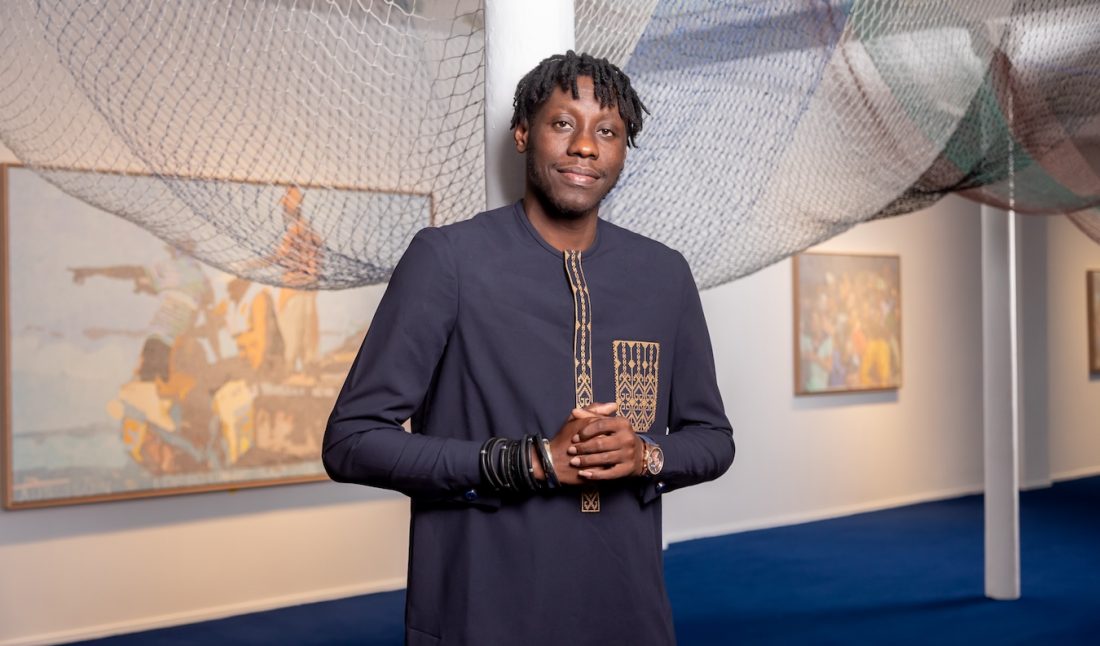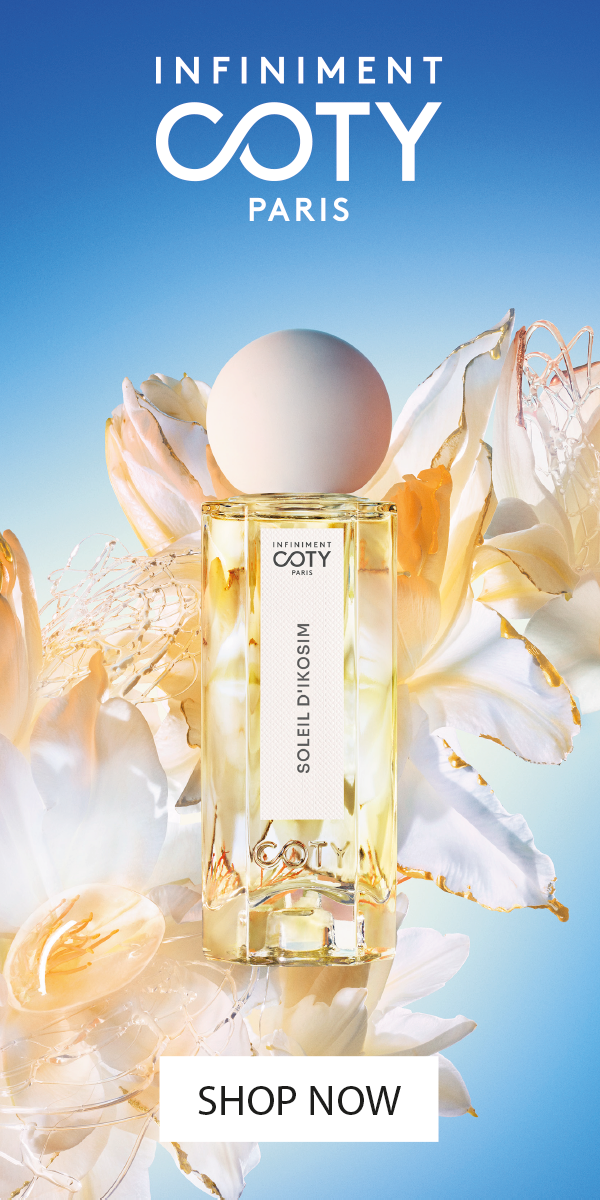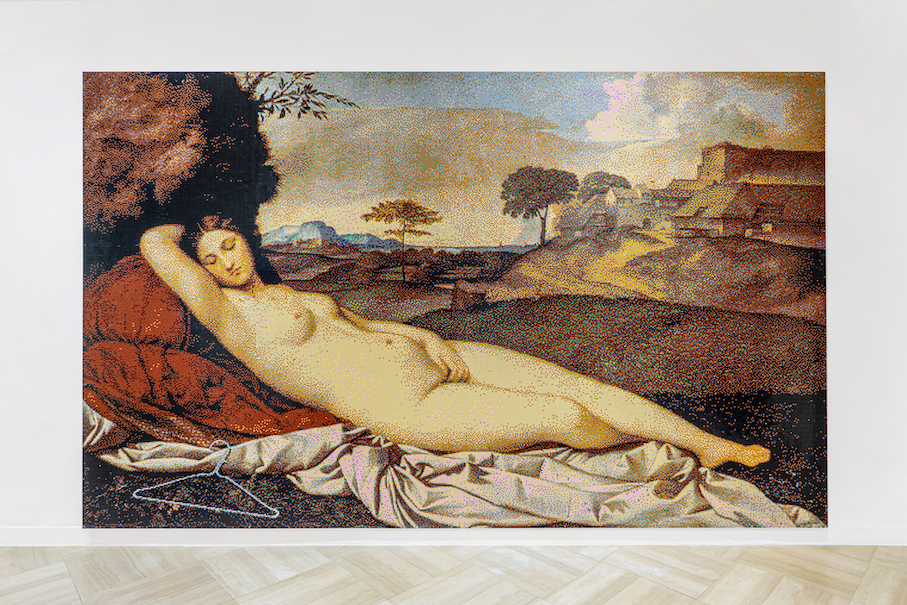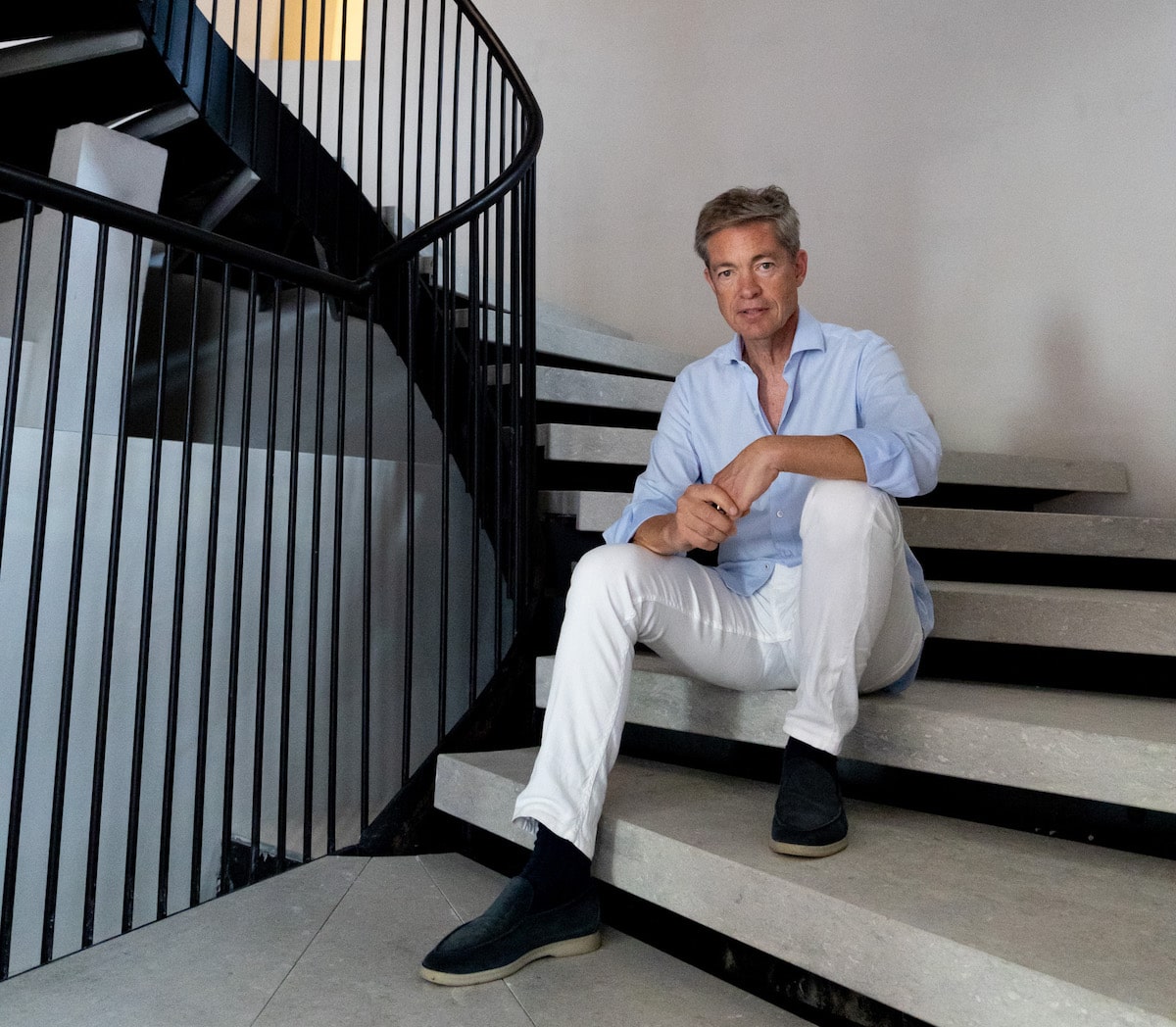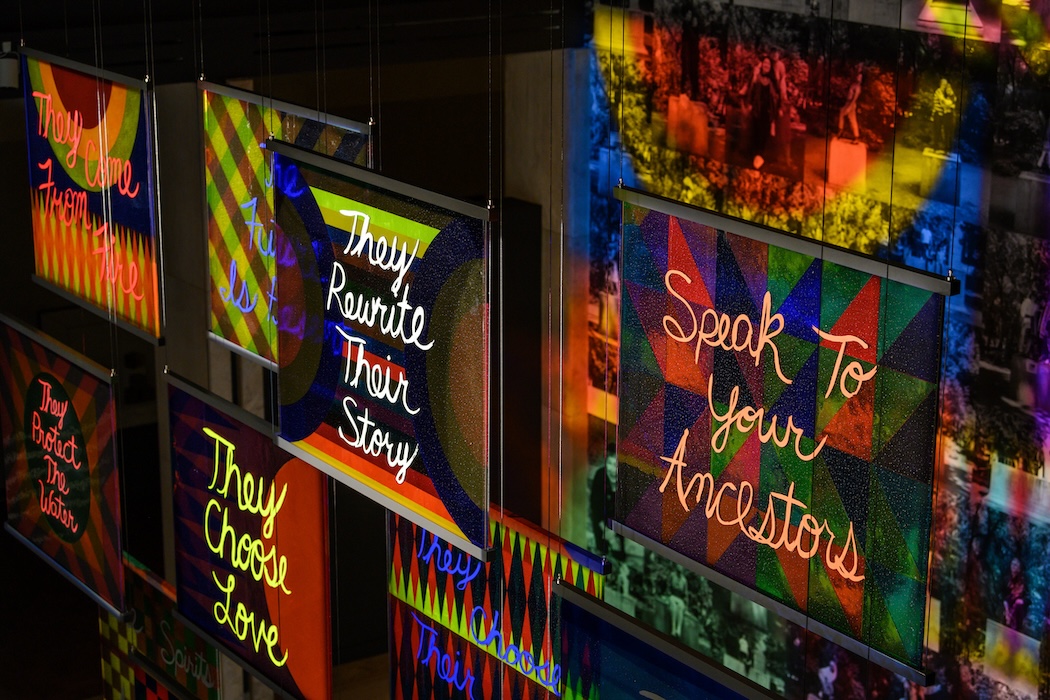The 60th International Art Exhibition La Biennale di Venezia, currently on view through November 24 in Venice, Italy, explores migrations and marginality through the vibrant lens of contemporary art. Senegal’s inaugural pavilion particularly shines with the poignant, signature artistry of Alioune Diagne. Ms. Marième Ba, Technical Counselor of the Ministry of Senegal’s Culture and Historical Patrimony and General Secretary of the Contemporary African Art of Dakar and the Senegalese Ministry of Culture and Historical Heritage, joins Massamba Mbaye, art critic, curator, and historian, to present revelatory works. Skillful and soulful in all regards, Diagne brings a hypnotic exhibition titled “Bokk – Bound” to Venice, enveloping visitors in his extraordinary “figuro-abstro” style of painting.
Energized by the nuances of calligraphy, Diagne evokes the ties that bind family and community through captivating and colorful script-like patterns, producing both realistic and dreamlike images of love, loyalty, and lineage. The chosen series of lush paintings creates an awe-inspiring display reminiscent of a puzzle that imparts emotional weavings of poverty, racism, education, and tradition through the presence of commanding female figures. Whitewall sat down with Diagne to discuss universal languages, the creative inversion of Charles Darwin’s evolutionary diagram, and exhibiting humanity’s flaws in an unwavering search for global harmony.
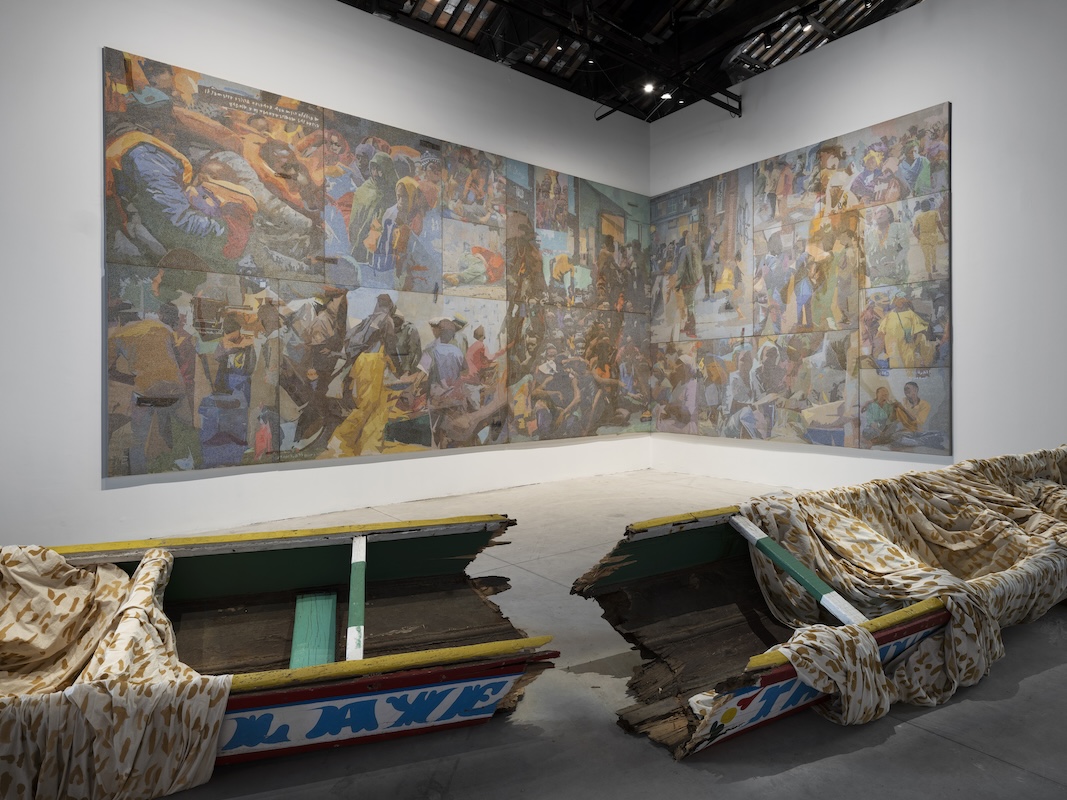 Installation view of Diagne for the Senegalese Pavilion, photo by © Ugo Carmeni, © courtesy of the artist and TEMPLON, Paris —Brussels — New York.
Installation view of Diagne for the Senegalese Pavilion, photo by © Ugo Carmeni, © courtesy of the artist and TEMPLON, Paris —Brussels — New York.
Alioune Diagne Represents Senegal at the Venice Biennale
WHITEWALL: Your project for the Senegal Pavilion at the 60th Venice Biennale is titled “Bokk – Bound,” with Bokk translating to “what is shared” and family connection. What were some of your primary influences in the realms of art, community, and family?
ALIOUNE DIAGNE: My primary source of inspiration is Senegal: the women in the markets, the fishermen, families and children I encounter in the streets. I am also deeply influenced by the daily lives of the African diaspora, which I’ve come to know through my travels, like in the United States, and during the last ten years living between France and Senegal. I draw inspiration from significant current events and testimonies of clandestine migrations, racism, or the plundering of resources in Africa, for example.
I created a project of 17 paintings that together form a mosaic of very different scenes. Initially, the project reaffirms the idea that we are all strangers to each other. I depicted very diverse scenes with a variety of perspectives, scales, and geographical areas.
The migrants depicted, as well as the homeless suffering from general indifference, also underscore the notion that we are all strangers. The collection of paintings and its interpretation are complex, reflecting humanity. Each painting can stand alone. In a way, the paintings are strangers to each other, though they are part of the same set. After the biennale, they will all be dispersed, and I like this idea because it makes me think of the African diaspora. Maybe one day they will be reunited?
In a second reading, I chose to show that beyond our differences we are interdependent and connected by our humanity. We are also linked by common values that I want to highlight: the education of children, the transmission of traditions, sharing, and the encounter with the other . . . These are values dear to me and that I generally celebrate in my work.
Even visually, I call for creating connections and living together by linking scenes through a consistent color palette and patterns that subtly extend from one piece to another. This includes, for example, an inverted version of Charles Darwin’s evolutionary diagram that appears as a watermark across the paintings. My style, “figuro-abstro,” also helps to connect these scenes and highlight the fact that humans are bound together.
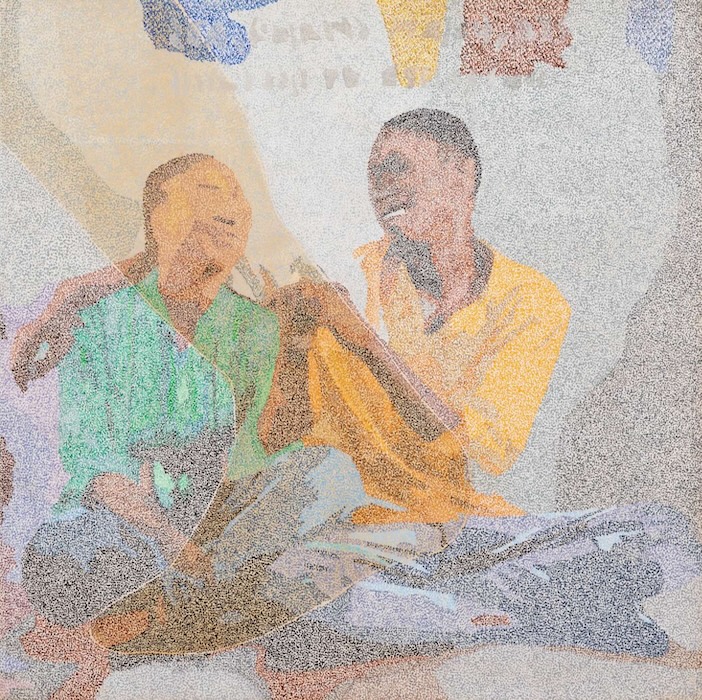 Alioune Diagne, “Mbëggeel – Love Bounds,” 2024, acrylic on canvas, 100 x 100 cm, photo by © Laurent Edeline, © courtesy of the artist and TEMPLON, Paris —Brussels — New York.
Alioune Diagne, “Mbëggeel – Love Bounds,” 2024, acrylic on canvas, 100 x 100 cm, photo by © Laurent Edeline, © courtesy of the artist and TEMPLON, Paris —Brussels — New York.
“The collection of paintings and its interpretation are complex, reflecting humanity,”
— Alioune Diagne
The Making of Alioune Diagne’s Signature “Figuro-Abstro” Technique
WW: Can you share the development of your mesmeric “figuro-abstro” practice and the inspiration of calligraphy to create abstract and immersive works of art?
AD: Figuro-abstro is a technique I spontaneously invented in 2013. I compose my scenes from a multitude of abstract elements that I call my unconscious signs. When you get close to my paintings, you see only these signs and abstract colored shapes, but as you step back, the figurative image gradually recomposes. This technique visually resembles calligraphy. The year 2013 was marked by the death of my grandfather, who was a Koranic master. I think his work with Arabic calligraphy stayed with me, and I mechanically began painting scenes with writings. My paintings thus contain a universal language: Everyone can find their references and see a meaning. Some people have seen references to a writing system used in Ethiopia or to Armenian writing, but for me, it’s a universal language, a common language to express what can’t be said with words.
WW: What was the process of creating this series of works, which culminate in a vast and enveloping presentation reminiscent of a puzzle, and how did it compare to past projects?
AD: This is a unique project as it’s the first time I’ve created 17 interrelated paintings. They form a set of 4 by 12 meters. It’s the most ambitious project I’ve undertaken. I outlined the overall image and the reversed evolution theory that crosses the paintings, then moved on to creating each painting. I worked on several paintings at the same time.
The project required finding technical solutions to regularly bring together all the paintings. I often went outside my studio, which didn’t have the necessary ceiling height, to find spaces that allowed me to connect the paintings and get a more global view.
WW: What is the creative ideation behind the words of hope found within your pieces and their specific placement on the canvas?
AD: The project’s composition contains a double movement. With the reversed evolution theory of Darwin’s diagram from man to monkey present from right to left, I show a regression of man who, through his indifference and selfishness, turns towards his primal instincts. He becomes closer to a wild animal, as depicted in the paintings.
This leads to what I show in the paintings: racism, the abandonment of the homeless, the scarcity of resources . . . I chose to bring a second movement into the overall composition. A movement from left to right, the natural direction of reading. We move from negative to positive towards joyful scenes. This shows the faith I have in humanity despite everything and the touch of hope I wish to convey.
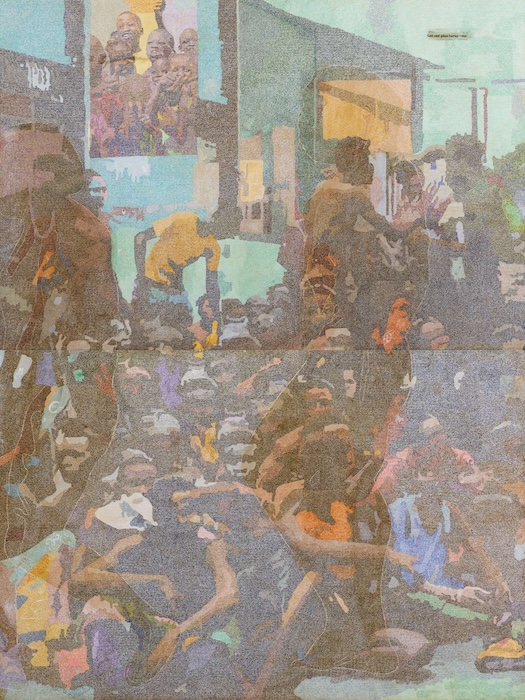 Alioune Diagne, “Transition,” 2023-2024, acrylic on canvas, 200 × 300 cm each, 400 × 300 cm, photo by © Laurent Edeline, © courtesy of the artist and TEMPLON, Paris —Brussels — New York.
Alioune Diagne, “Transition,” 2023-2024, acrylic on canvas, 200 × 300 cm each, 400 × 300 cm, photo by © Laurent Edeline, © courtesy of the artist and TEMPLON, Paris —Brussels — New York.
“It’s the most ambitious project I’ve undertaken,”
— Alioune Diagne
WW: The individuals in your artworks range with profound meaning in their ages, gestures, emotional and physical states, as well as proximity to one another. How do you arrive at these expressive images? Are any of them perhaps portraits of people you know?
AD: The individuals in my paintings are not always individualized because I want the viewer to feel them, to have the impression they know them. They are often drawn from my imagination and have traits general enough to give this impression. Sometimes, the faces even lean towards abstraction, and anyone can identify with them. This is the case for characters in the more positive part of the project, which are more abstract. Other characters look directly at the viewer to capture their attention and involve them in reading the work to understand the messages I try to convey.
WW: What inspirations do you hope to spark in visitors as they traverse both the distinct and universal themes in your works, including poverty, racism, and global apathy, as well as children’s education and the honoring of one’s heritage?
AD: Everyone can interpret my paintings as they wish, and I offer a multitude of details that can have different meanings to different people.
What I want with this project is to provoke awareness. I address subjects that are important today, even fundamental. I represent them with my technique, my aesthetic, and colors that are attractive. I’d like visitors who stop at the visual aspect to take the time to gradually understand the messages I’ve tried to convey . . . I hope the new generation understands the current issues such as racism, the increasing poverty that drives populations to migrate under terrible conditions and in indifference . . .
For me, the youth are our future, and education is a subject close to my heart. It’s the subject of one of the project’s paintings. I wish for young people to have access to art and culture, even in villages in Senegal. It’s an opportunity I didn’t have.
I’m also honored to be the first artist to represent Senegal at the Venice Biennale as it paves the way for a whole generation of Senegalese artists to exhibit there.
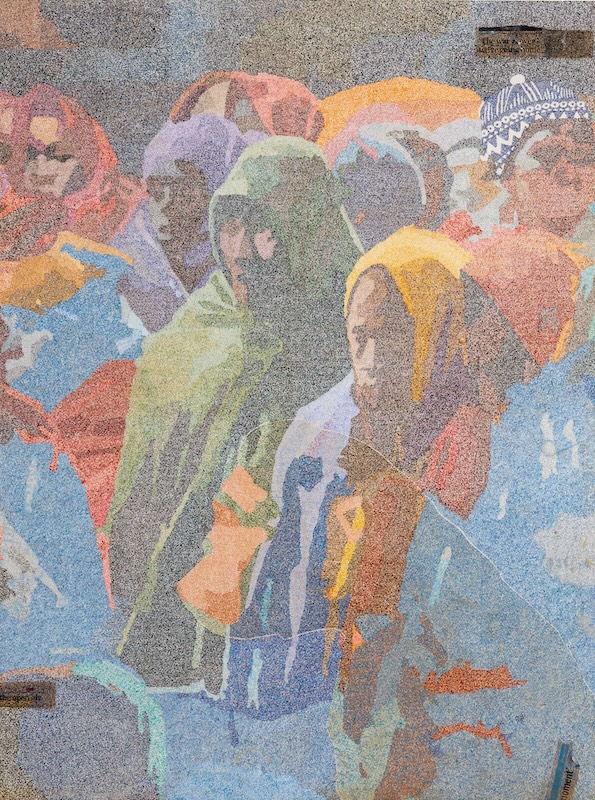 Alioune Diagne, “Malaanum Fippu – The Veil of Peace (detail),” 2023-2024, acrylic on canvas, 200 × 150 cm, photo by © Laurent Edeline, © courtesy of the artist and TEMPLON, Paris —Brussels — New York.
Alioune Diagne, “Malaanum Fippu – The Veil of Peace (detail),” 2023-2024, acrylic on canvas, 200 × 150 cm, photo by © Laurent Edeline, © courtesy of the artist and TEMPLON, Paris —Brussels — New York.






